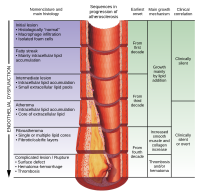
Photo from wikipedia
We have made enormous strides in atherosclerosis research over the last century. The story of the cholesterol hypothesis provides a model whereby decades of fundamental research bore fruit when translated… Click to show full abstract
We have made enormous strides in atherosclerosis research over the last century. The story of the cholesterol hypothesis provides a model whereby decades of fundamental research bore fruit when translated to the clinic.1 This victory of basic science intertwined with clinical development merits revisiting as it furnishes a pathway that can inspire us and prod us to achieve a similar goal with remaining risk factors beyond cholesterol (cover Figure) but more quickly and adding to the effectiveness of treatment of cholesterol. The story of cholesterol in atherosclerosis begins experimentally with the work of Anichkov and Chalatow,1,2 who demonstrated the creation of fatty lesions in the arteries of rabbits that consumed a diet enriched in cholesterol. Windaus3 chemically characterized cholesterol in atherosclerotic plaques. A technological advance spurred the next chapter in the cholesterol story. The advent of the ultracentrifuge equipped Lindgren et al4 in the middle of the 20th century to characterize the lipoproteins that bear cholesterol and other lipids in the bloodstream. This work ushered an era of rapid progress in the characterization of different classes of lipoproteins, their correlation with disease states, and their chemical characterization. Lindgren et al4 recognized LDLs (low-density lipoproteins) and HDLs (high-density lipoproteins)—a classification that permitted them and many others to pinpoint LDL as a risk factor for atherosclerotic cardiovascular disease. The unraveling of the LDL receptor pathway provided the next boost to cholesterol research.5 The discovery by Endo et al6 of natural products that inhibit hydroxymethylglutaryl coenzyme A, the rate-limiting step in the synthesis of sterols, a pathway elucidated by Bloch,7 opened the door to the development of effective new treatments for atherosclerotic cardiovascular disease by statins. The discovery by industrial investigators of ezetimibe, which acts, in part, by inhibiting cholesterol absorption in the small intestine, led to the discovery of the important role of the cholesterol transfer protein NPC1L1 (NiemannPick C1-like 1 protein) in enterocytes. Inhibition of NPC1L1 can lower LDL cholesterol independently of statins.8,9 The observations of Catherine Boileau in kindreds with autosomal dominant hypercholesterolemia, coupled with the biochemical observations of Nabil Seidah, led to the cholesterol-regulating role of PCSK9 (proprotein convertase subtilisin/kexin type 9). This protein became the target of another series of LDL cholesterol therapeutics, both neutralizing antibodies and a small interfering RNA.10 Large-scale clinical trials validated the ability of PCSK9 inhibition to improve cardiovascular outcomes.11,12 This evolution from basic discovery to clinical translation took all in all more than a century but provided us with the tools to lower LDL cholesterol markedly and enabled enormous inroads into the prevention and treatment of cardiovascular diseases. But, the battle, although joined, is not yet won. A considerable residual burden of cardiovascular disease persists despite substantial LDL lowering and other highly effective preventive measures ranging from smoking cessation through treatment of hypertension. Coronary heart disease remains a leading cause of disability and death in the developed world.13 With the epidemiological transition in the developing world, the epidemic of atherosclerotic disease has spread globally, threatening vast numbers of individuals. The waning of many communicable diseases permits survival such that atherosclerotic cardiovascular disease can develop later in life. In both the developed world and countries in development, the global increase in aging also fuels atherosclerotic cardiovascular disease.14
Journal Title: Circulation research
Year Published: 2020
Link to full text (if available)
Share on Social Media: Sign Up to like & get
recommendations!